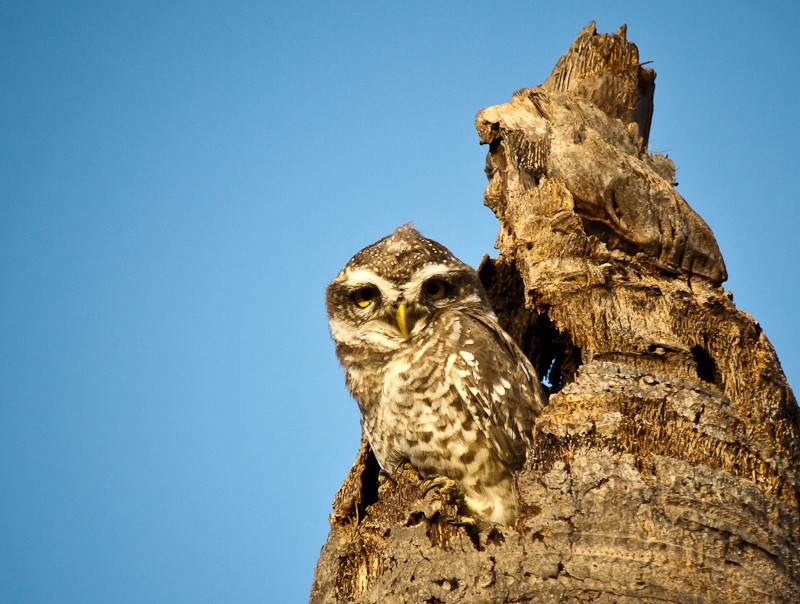Spotted Owlet
A species of Little and Burrowing Owls and Allies Scientific name : Athene brama Genus : Little and Burrowing Owls and Allies
Spotted Owlet, A species of Little and Burrowing Owls and Allies
Botanical name: Athene brama
Genus: Little and Burrowing Owls and Allies
Content
Description People often ask General Info
 Photo By Mymoon Moghul , used under CC-BY-SA-4.0 /Cropped and compressed from original
Photo By Mymoon Moghul , used under CC-BY-SA-4.0 /Cropped and compressed from original Description
The spotted owlet is a small and stocky bird, barely 21 centimetres (8.3 in) in size. The upperparts are grey-brown, heavily spotted with white. The underparts are white, streaked with brown. The facial disc is pale and the iris is yellow. There is a white neckband and supercilium. Sexes are similar. The flight is deeply undulating. The nominate form is darker than the paler forms such as indica of drier regions. 
Size
21 cm
Colors
Brown
Gray
White
Nest Placement
Cavity
Feeding Habits
Spotted Owlet predominantly feeds on insects and small vertebrates. Spotted Owlet adapts its diet geographically, consuming more rodents in arid regions, particularly during breeding season. Additionally, spotted Owlet preys on bats, toads, small snakes, scorpions, and molluscs, showcasing diverse feeding behaviors and dietary preferences.
Habitat
The spotted Owlet is predominantly found in open and semi-open landscapes, preferring habitats ranging from agricultural land to urban settings. This includes areas like farmlands, towns, and cities, where they have become well-adapted to human presence. They tend to avoid dense forests, instead favoring lighter woodlands, deserts, semi-deserts, and particularly suburban settings such as mango groves, up to an altitude of around 1600 meters. Roosting in small groups, they occupy tree hollows or cavities in rocks and buildings, where they also nest and lay their eggs.
Dite type
Insectivorous
People often ask
General Info
Feeding Habits
Bird food type
Behavior
This species is nocturnal but is sometimes seen in the day. When disturbed from their daytime site, they bob their head and stare at intruders. It can often be located by the small birds that mob it while it is perched in a tree. It hunts a variety of insects and small vertebrates. In Pakistan they have been found to take mostly insect prey. In the arid region of Jodhpur, they have been found to take more rodents (especially in the genus Mus and tend to avoid other rodents such as Tatera) prior to the breeding season. Bats, toads, small snakes such as Ramphotyphlops braminus have been noted. They may also take scorpions and molluscs. Nests near human habitations may show higher breeding success due to increased availability of rodents for feeding young. The call is a harsh and loud churring and chuckling chirurr-chirurr-chirurr ending with a chirwak-chirwak and they call mainly during early dawn or just after sunset. The breeding season is November to April. Courtship behaviour includes bill grasping, allopreening and ritual feeding. The female may call with the male, bob head and deflect its tail in invitation. The social organization of family groups is not clear and multiple males may copulate with a female and females may attempt pseudocopulation, possibly a kind of displacement behaviour. They nest in cavities often competing with other hole-nesters such as mynas, rollers and parakeets. They may also nest in holes in vertical embankments. The nest may be lined with leaves and feathers or may use the existing lining from a prior occupant. The typical clutch is made up of three or four spherical white eggs (30.9mm long and 26.3 mm wide, 11.6g) and incubation begins with the first laid eggs leading to a wide variation in the size of the chicks. The young are fed initially on insects such as cockroaches and later fed small vertebrate prey such as mice (a toad Bufo stomaticus has been noted in Gujarat). The chicks gain weight during the early stages but lose weight before fledging. Only one or two chicks may fledge and they leave the nest in about a month. The brain has a pineal gland, formerly thought to be absent in the owls. Birds show variation in the melatonin concentration between day and night. A high melatonin level is associated with sleep and low levels are associated with high alertness and foraging activity. Spotted owlets, however, show only a slightly lower melatonin concentration at night with a slight increase in the early afternoon. Other owls such as the barn owl show little day-night variation. Seasonal changes in glandular activity have been associated with environmental factors such as temperature and humidity. A coccidian parasites, Eimeria atheni, has been described from this species. An ectoparasitic mite, Neocheletiella athene, has been described from a specimen from the Antwerp zoo. Bird lice of the species Colpocephalum pectinatum are known to be ectoparasites. The Acanthocephalan parasite Apororhynchus chauhani was discovered in the intestine of the spotted owlet. 
Species Status
Not globally threatened.